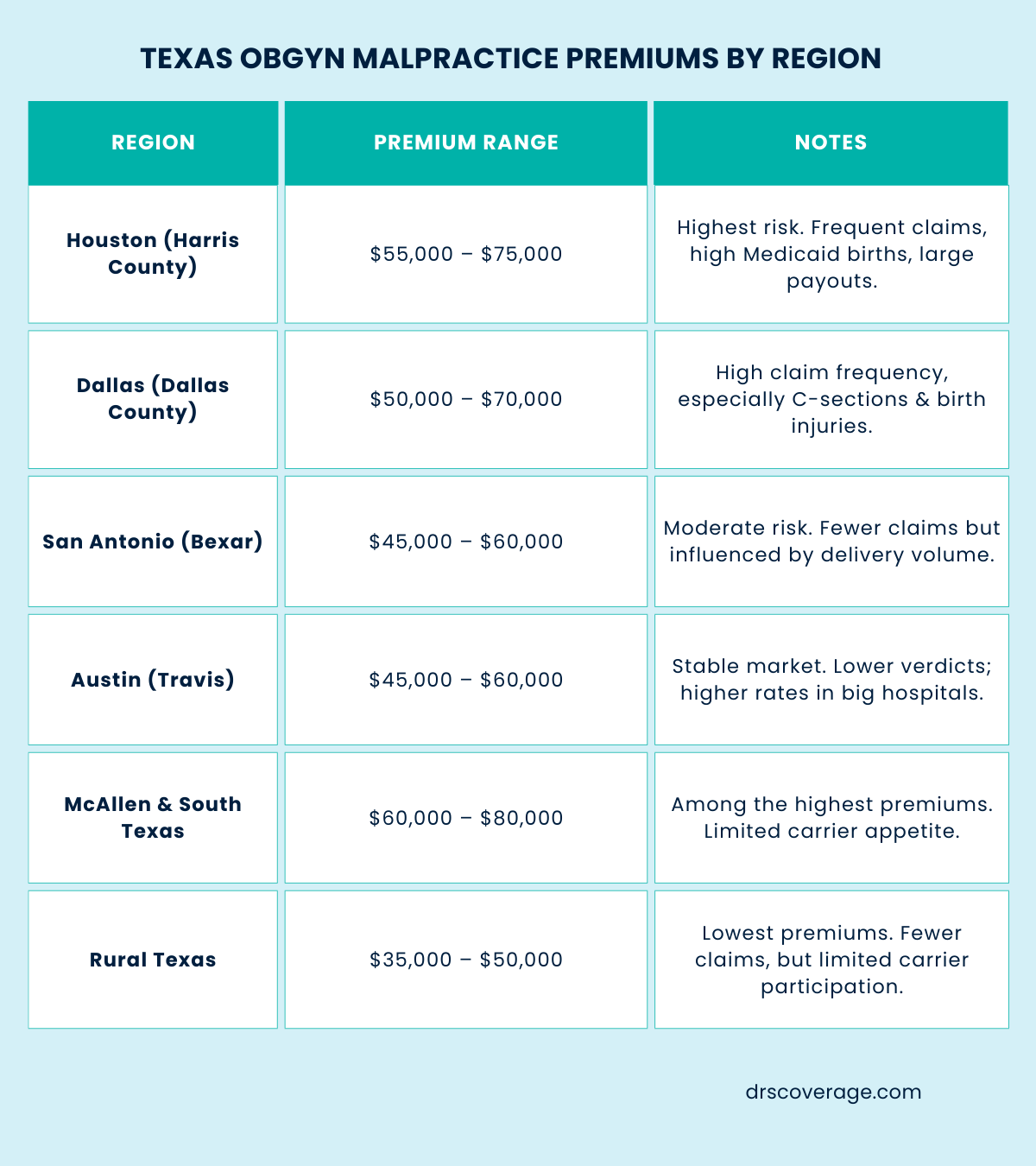Practicing as an OBGYN in Texas means working in one of medicine’s highest-risk specialties - within a state that has its own set of rules, pressures, and premium patterns.
While tort reform has helped keep average rates more stable than in some high-liability states, OBGYNs still face elevated costs in areas like Houston, Dallas, and McAllen - and long-tail claims from birth injuries that can surface years after delivery.
This guide breaks down how malpractice insurance works for OBGYNs in Texas - from regional premium differences and carrier underwriting trends to tail coverage, hospital credentialing, and the policy details that can affect your exposure years after you stop practicing.
Malpractice Insurance Premiums
In Texas, OBGYNs pay some of the highest malpractice insurance premiums among medical specialties.
Frequency of Malpractice Claims
Indemnity Payments
Legal Environment
Common Allegations in OB/GYN Malpractice Claims
OBGYN Liability Claim Trends in Texas: What the Data Shows
Malpractice claims involving OBGYNs in Texas follow clear patterns - and they carry real financial weight.

OBGYN sits near the top of every malpractice ranking, and Texas follows the same pattern. Labor and delivery carry unique risks - complications can escalate within minutes and often have lifelong consequences for both mother and child.
One challenge is the long-tail nature of claims. A birth injury lawsuit might not appear until years later, particularly when developmental delays or neurological concerns take time to show.
When these cases do surface, they tend to involve large payouts. Juries often award substantial amounts in infant-related cases, reflecting both the cost of long-term care and the emotional weight of the outcome.
Finally, geography matters. In counties with a long history of obstetric litigation and higher delivery volumes, premiums are priced at the very top of the range.
OB/GYNs face recurring malpractice risks nationwide, but in Texas those risks are shaped by regional litigation patterns and the state’s longer claim window. The most frequent allegations involve labor, delivery, and surgical complications - issues that carry added weight under Texas tort law and county-level claim severity.

Most OBGYNs in Texas are insured through claims-made policies. These policies only respond if both the incident occurs and the claim is reported while the policy is active. Because malpractice claims involving deliveries can surface years after the event, coverage continuity is especially important.

Unlike some other states, occurrence-based policies are rarely offered in Texas for OBGYNs due to the high cost and limited carrier appetite. That makes tail coverage a critical consideration whenever a physician changes insurers, leaves a group, or retires.
Tail coverage is typically priced at 200–250% of the expiring annual premium, though some carriers offer free or discounted tail if eligibility requirements are met (such as retiring after a certain age). Without tail coverage, lawsuits filed after the policy ends are not covered, even if the event took place during the prior policy period.
For OBGYNs, this gap can be financially devastating because birth injury claims are among the most severe in medical malpractice litigation. Texas law allows families to file lawsuits years after delivery, making tail protection essential.
Learn more about policy structures: Claims-Made vs Occurrence Policies
For OBGYNs in Texas, annual malpractice premiums usually fall between $45,000 and $75,000. The exact number depends on factors like location, delivery volume, practice structure, and claims history. This assumes the standard $1M/$3M coverage limits.
Premiums can climb higher. A solo OBGYN practicing in a litigious county or carrying prior claims may see rates above $90,000. On the other hand, younger physicians in group practices or lower-risk counties often fall toward the bottom of the range.
In general, solo surgeons, high-volume OBs, and those with a claims record will pay the most - especially in areas with frequent litigation.

Several underwriting considerations drive premium pricing:
When closing a practice or switching carriers, tail coverage becomes a major consideration. For OBGYNs, tail is usually 1.5 to 2 times the annual premium - often in the $90,000 to $150,000 range.
Some carriers waive the cost under specific conditions, such as retirement at a certain age or uninterrupted coverage with the same insurer. Because terms vary, it’s important to confirm eligibility before making a transition.
Independent brokers can manage the entire quoting process, including gathering information, submitting applications to multiple carriers, and identifying differences in policy structure.
Geography continues to be one of the biggest influences on malpractice insurance premiums. Tort reform has stabilized rates overall, but regional differences remain substantial.

Texas isn’t a uniform market - carriers underwrite by region. In certain high-risk counties, insurer participation is more limited. Areas like Harris (Houston), Dallas, El Paso, Hidalgo (McAllen), and Cameron (Brownsville) carry a history of elevated birth injury settlements and frequent obstetric litigation, which makes coverage harder to place.

By contrast, rural counties and lower-volume practices tend to attract more carrier appetite.
When reviewing applications, underwriters focus on:
The same OBGYN may receive quotes 20–30% higher in McAllen compared to a nearby rural county, purely due to geography and claims history.
Texas has operated under tort reform since 2003 - and for OBGYNs, that distinction matters.
The reforms placed limits on certain damages, especially in high-risk specialties like obstetrics:

Texas law also extends the statute of limitations in certain cases:
This extended window is why tail coverage is so important for OBGYNs - exposure doesn’t end when your contract ends.
What the 14-Year Rule Really Means
A birth injury that appears minor at delivery could lead to litigation years later, often when a child starts school. Tail coverage keeps protection in place long after you’ve moved on.
Another policy detail worth close review is the consent-to-settle clause. The language in this section determines whether you have the final say in how claims tied to your name are resolved.
Common structures include:
For OBGYNs concerned about reputation or licensing board reporting, these provisions matter. They’re not just fine print - they shape how your malpractice record is managed.
Hospitals don’t just look at your CV - malpractice insurance is often a key part of the credentialing checklist.
If you’re practicing in a major metro like Houston, Dallas, or San Antonio, expect hospitals to require proof that your coverage meets their benchmarks.
Most large systems require:
Credentialing may be delayed - or denied - if your insurer isn’t on the facility’s approved list. Switching carriers mid-career can also trigger a new credentialing review.

Texas often looks favorable for physicians because of tort reform - and in many ways, it is. Compared to states like New York or Florida, OBGYNs here typically pay lower base premiums, particularly at standard limits of $1M/$3M.
Tort reform also caps non-economic damages at $250,000 per physician, with a combined maximum of $750,000 if multiple parties are named. Those caps have helped reduce the size of jury verdicts and kept premiums more stable.
But Texas is not a “low-risk” environment. The discovery rule allows birth injury claims to be filed until the child turns 14, which means physicians can face litigation long after a delivery - even after leaving a group or retiring.
Risk also varies by region. Counties such as Harris, Dallas, and Hidalgo see more frequent claims and higher payouts than other parts of the state.

Compare OBGYN Malpractice Insurance Quotes in Texas
Malpractice coverage for OBGYNs in Texas goes beyond price. The real challenge is finding a policy that fits your contracts, career stage, and long-term risk.
OBGYN is one of the most complex specialties to insure. Tail obligations, group versus individual structures, prior claims, and even the language in your employment contract can all influence your options. These details directly affect your job mobility, contract negotiations, and whether you risk gaps in protection.

A knowledgeable broker helps by comparing policies across multiple carriers, flagging contract terms that may impact coverage, and translating insurance language into plain English. More importantly, they can identify options that align with your claims history and career goals so you don’t have to sort through the fine print alone.
Schedule a consultation with a licensed medical malpractice insurance broker. You can also request a quote to get started or email us with any questions. If you have a recent carrier application (such as last year’s), it may help us provide initial indications faster. A DrsCoverage broker is available to assist you at any stage.